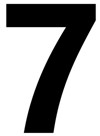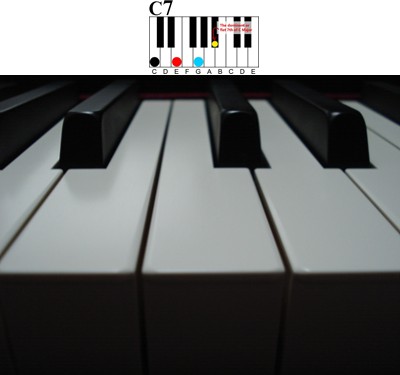
It’s very simple to play dominant 7th chords on the piano. Dominant 7th chords are so common in popular music that a lot of musicians don’t really consider them to be extended chords. To be technical, they are extended chords but I think they deserve their own category because there are two different types of 7th chords. There are Major 7th Chords and Dominant 7th chords.
Today, I want to cover how to play dominant 7th chords on the piano. But first, I need to answer the question: What are dominant 7th chords? Where do they come from and how are they different than just plain Major chords?
Let’s start out with a plain C Major triad to help us illustrate our first example of a dominant 7th chord.
A C Major triad consists of C E & G. It has the first, third and fifth degrees of the Major scale.
 In order to transform this plain Major triad into a dominant 7th chord, you must add the dominant 7th note to it.
In order to transform this plain Major triad into a dominant 7th chord, you must add the dominant 7th note to it.
The dominant 7th is also referred to as the flat 7th in any given key. Start off by finding the 7th note in the key by counting up from C to B. (1 through 7) Now flat the 7th tone from B to B flat.
Now flat the 7th tone from B to B flat. 
Add the flat 7th to the C Major triad. You now have the C dominant 7th Chord.

This is the most linear way to define and construct a dominant 7th chord. But there’s actually an easier way to find the dominant 7th chord on the piano. It’s a simple shortcut based on finding the root of the chord and locating the dominant 7th from there.
Instead of counting up from the root, you can simply move a whole step down from the root to find the dominant 7th.
To find the dominant 7th of C, move a whole step down from C to B flat. This is a more direct approach. It’s also an easier way to find the dominant 7th of any other Major chord. Even though you’ve located the dominant 7th below the root, you don’t have to play it in this register. Just simply move it up an octave to where you played it earlier when you counted up from the root.
Even though you’ve located the dominant 7th below the root, you don’t have to play it in this register. Just simply move it up an octave to where you played it earlier when you counted up from the root.
 Now let’s take this concept to another Major chord to find a dominant 7th chord on the piano.
Now let’s take this concept to another Major chord to find a dominant 7th chord on the piano.
A D Major triad consists of D F# & A.
 The dominant 7th is located a whole step down from D which is C.
The dominant 7th is located a whole step down from D which is C.

Move it up an octave as you did before. You now have the D dominant 7th Chord.

Let’s try F# Major to create a dominant 7th chord.
An F# Major triad consists of F# A# & C#.
 The dominant 7th is located a whole step down from F# which is E.
The dominant 7th is located a whole step down from F# which is E.
Move it up an octave as you did before. You now have the F# dominant 7th Chord. You can find the dominant 7th of any Major chord with this very simple strategy. Make an exercise of finding the dominant 7th of all other chords that we didn’t cover in our examples.
You can find the dominant 7th of any Major chord with this very simple strategy. Make an exercise of finding the dominant 7th of all other chords that we didn’t cover in our examples.
Just remember that locating the flat 7th below the root of the chord is just a simple strategy and you can play them an octave higher. When you become more familiar with dominant 7th chords, you’ll easily be able to form them without having to think about where the dominant 7th is located.
Now that we understand how to create a dominant 7th chord, let’s analyze them to see what gives them their distinctive sound.
Play the C dominant 7th chord and listen to the sound of it.
 It has a dissonant quality to it. So what exactly gives the dominant 7th chord its dissonant quality?
It has a dissonant quality to it. So what exactly gives the dominant 7th chord its dissonant quality?
Again, the C Major chord has the root, third and fifth degrees of the Major scale. Add the flat 7 to complete the dominant 7th chord.
Here’s the interesting fact about dominant 7th chords. They contain the interval known as a tritone within the chord. Just look at the third and flat 7th by themselves.

This is a diminished 5th interval. If you play this interval by itself you can clearly hear where dominant 7th chords get their distinctive sound.
What’s the best way to learn how to illustrate dominant 7th chords on the piano? With the blues of course. Even though these chords are played in all kinds of music, they’re most indicative of blues music in nature.
Here’s three dominant 7th chords you’ll often hear together in a blues progression in the key of C Major.
 Please be aware that you can play them in different inversions or voicings. They don’t have to be played in root position.
Please be aware that you can play them in different inversions or voicings. They don’t have to be played in root position.
The preceding chords are in a format called Keyshots in which each color represents a numbered tone within the chord. Find out more about them here.
Just a few notes about dominant 7th chords: They’re often referred to as 7th chords without a mention of the word “dominant”. They’re notated in chord charts and lead sheets with only the number 7 next to the lettered chord symbol.
“dominant”. They’re notated in chord charts and lead sheets with only the number 7 next to the lettered chord symbol.
 The dominant 7th chord is often built on the fifth note in a key of music. This is also known as the 5 chord and it has a strong pull to the 1 chord. This means that when you hear a dominant 7th chord based on the 5th note in a key of music, it’s often followed by the 1 chord in a song. This creates resolution in a chord progression and can end a song or be a turnaround to repeat the progression.
The dominant 7th chord is often built on the fifth note in a key of music. This is also known as the 5 chord and it has a strong pull to the 1 chord. This means that when you hear a dominant 7th chord based on the 5th note in a key of music, it’s often followed by the 1 chord in a song. This creates resolution in a chord progression and can end a song or be a turnaround to repeat the progression.
A couple more things about dominant 7th chords: They’re not to be confused with Major 7th chords or minor 7th chords. Major 7th have a different character to them and minor 7th chords have a minor 3rd in them and a more consonant sound.
Closing Thought
Dominant 7th chords are found everywhere. You should get as familiar as you can with them because there such an integral part of popular music; especially dominant 7th chords on the piano. The examples I showed you here a small portion of the dominant 7th chords that are available to you. Remember, you have 12 possible dominant 7th chords because you have 12 different keys. Until next time, Go Play!
Greg Lee
Latest posts by Greg Lee (see all)
- What is a minor/Major 7 Chord? - October 26, 2023
- 7 Chord Substitutions that Professionals Use - October 19, 2023
- 5 Simple Chord Tricks to Sound Amazing - October 5, 2023





